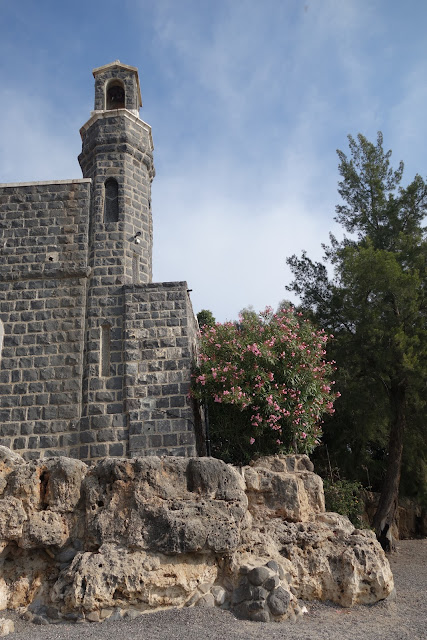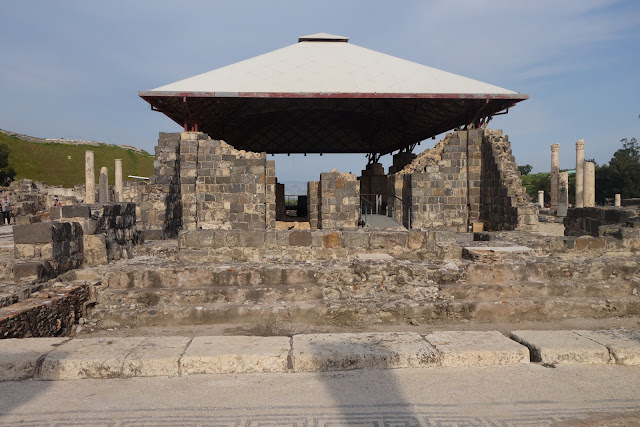Today, Tuesday. March 17, we headed to Tabgha.
We stopped at the Church of the Primacy of St. Peter. Here, it is traditionally believed, is the spot Christ said, "...thou art Peter, and upon this rock I will build my church; and the gates of hell shall not prevail against it."
The current 1933 church is built on the old 4th century church.
This church appears to literally be built upon a rock.
The bronze door at the church's entrance.
Inside the church is the Mensa Christi, or table of Christ.
According to tradition, Christ told Peter to "feed my sheep" after
laying out a meal of fish and breadfor his apostles on this stone table.
Tabgha is the place Christ fed the 5000 with just a few loaves and fishes.
This church is right on the edge of the Sea of Galilee.
The shore was covered in shells, and I hope no one minds that I brought a few home.
Our next stop is Mount Arbel.
Again, I'm am enchanted by the variety of beautiful Israeli wildflowers.
Mount Arbel is one of those magical lookout spots, and you can see the Sea of Galilee, the Golan, and Mt. Hermon from here..
By the time I deciphered the first two lines....
My notes say that over the centuries, people built homes right into the cliffs and caves of the area.
With these views, I can see why.
Water is a precious commodity in Israel, and there is an ongoing shortage. Israelis are efficient and dedicated water-recyclers.
We moved on to Bet She'an. This place was just incredible. I have always thought Roman ruins were in, well..... Rome! I had no idea these sorts of ancient ruins were everywhere in the countries we visited.
Bet She'an is found at the junction of the Jordan River Valley and the Jezreel Valley. Archeologists believe this city had inhabitants as long ago as the 5000-3600 BC. That is so incredibly old, it's hard to comprehend.
Of course, these ruins aren't that old. Remains of cities ranging from Egyptians (3600-1130 BC), to The Judges (1140-1000 BC), to the Israeli Kingdom (1000-732 BC) have been found and identified.
In 732 BC the city was destroyed by an invading army, and was more or less unoccupied until 333-63 BC when it was a Hellenistic city. The Romans took over in 63 BC- 324 AD. The city was a Christian city during the Byzantine Era (324-632 AD)
The city was inhabited by Muslims from 632 AD- 1099 AD. The city was destroyed in 749 by a serious 7- 7.5 earthquake.
Crusaders built a fortress at a new site and a small village sprung up at the old.
Finally, the Mamluk and Ottomans occupied the area from 1260-1917.
There's still lots of beautiful mosaic floors
and columns that anciently would have had a roof of some sort.
One of the many claims-to-fame of this city is that the bodies of Saul and his sons
were displayed on the city walls.
This is the bathhouse, which included hot and tepid halls. The floor would have been suspended over these clay pillars.
Explanation of how the heating worked.
This is the communal bathroom with several toilets.
Thanks, but I prefer my own room with a locking door.
Things found by archeologists in the bath area, including oil flask, dishes for splashing yourself with cold water, and tools to clean ears, nails, and skin.
The bricks of these walls would have been covered with plaster,
and you can still see the paintings on them in some areas.
Another shot of the public toilets from another angle. According to a nearby sign, toilet tissue was a soft leaf attached to a twig. I'm sticking with Charmin.
More mosaic floors in the bathhouse area, also in surprisingly good condition
An example of how a roof of the time period may have looked.
This must have been a large, bustling city in its prime.
I'm not really crazy about this modern addition, but it does show how massive the columns were.
A lion craving.
A beautiful capital. Note the face of Dionysus, Greek god of wine and patron of the city.
There is some restoration going on.
Two ancient ruins visiting the ancient ruins
People who study such things can tell a lot from these fallen pillars, casualties of the 749 earthquake, like the magnitude and direction of the epicenter.
It is astonishing to walk through a city this old.
To the right is a hill called a Tel. The Tel started as a natural hill, but was added on over time. It would have been the site of churches and temples, as well as government headquarters, depending on who controlled the city. Archaeologists have found 20 distinct layers of cities.
The flat area on the right side of this picture is a Sigma, an ancient shopping area or brothel.
This is the stage of the theatre, built around the 1 century AD.
The visit to these ruins was unexpected, interesting, and gorgeous.
Our final stop of the day was back to Jordan River. I was trying to take a picture of the sign, but got an interesting picture of this person instead. We saw an incredible variety of religious dress in Israel.
This is one of the "official" sites of Christ's baptism.
It's a bit too commercialize for me.
It is clearly a mecca for religious people.
We saw a number of people being baptized at this spot.
We've finished another day, packed with incredible sites. We are nearly done with the Israel part of our journey.
















































































That is one of my favorite stories, of Christ feeding the 5,000. Also, I picked the wrong spot to be baptized. I wish I would have been baptized in the Jordan River! ;)
ReplyDeleteI loved the bathhouse at Beit She'an. You had some details I didn't know. Can you imagine living in stone houses like that?
ReplyDelete